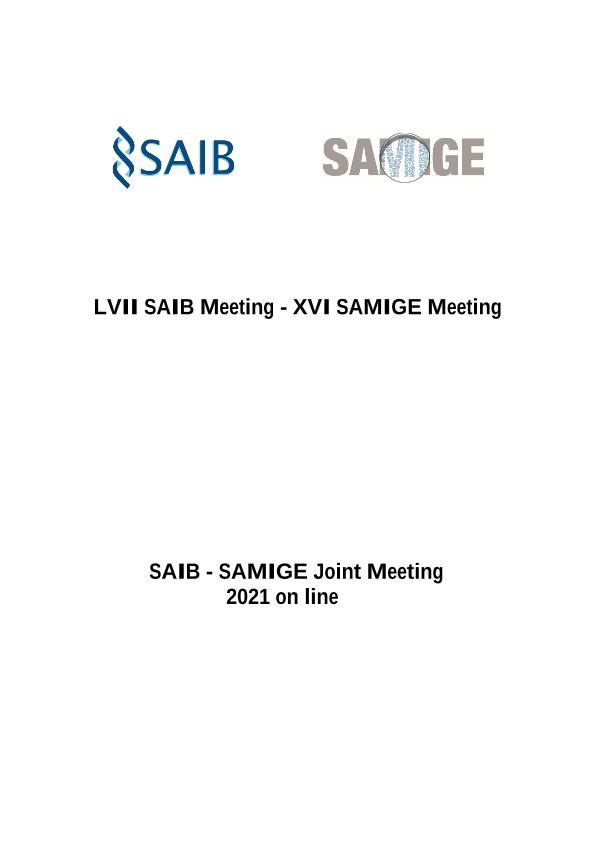Mostrar el registro sencillo del ítem
dc.contributor.author
Santiago Valtierra, Florencia Ximena

dc.contributor.author
Luquez, Jessica Mariela

dc.contributor.author
Oresti, Gerardo Martin

dc.date.available
2023-01-20T16:54:00Z
dc.date.issued
2022
dc.identifier.citation
Ex vivo progression of spermatogenesis entails accretion of lipids with long and very-long-chain polyenoic fatty acids; LVII Annual Meeting of the Argentine Society for Biochemistry and Molecular Biology Research and XVI Annual Meeting of the Argentinean Society for General Microbiology; Virtual; Argentina; 2021; 47-47
dc.identifier.issn
0327-9545
dc.identifier.uri
http://hdl.handle.net/11336/185154
dc.description.abstract
Spermatogenesis can proceed ex vivo in neonatal mouse testes using a gas-liquid interphase culture system. Previously we observed both in vivo and ex vivo, a relationship between the progression of spermatogenesis (at cytological and histological level) and the gene expression of some of the enzymes involved in fatty acid and lipid biosynthesis. The aim of this study was to survey whether the same developmental changes that occur in vivo in the testicular lipids that contain long-chain (C18-C22) and very-long-chain (C24-C32) polyunsaturated fatty acids (PUFA) are present in neonatal testis explants kept in culture. Testis explants from 6-day old mice cultured for 22 days evidenced a progress in spermatogenesis beyond the meiotic phase in some of the tubules. The appearance of haploid germ cells concurred with an increase in the expression of Fabp9, Dgat2 and Fa2h. Notably, genes involved in PUFA biosynthesis (Elovl2, Elovl4, and Fads2) were up-regulated in the testicular explants in comparison with the in vivo situation. Interestingly, during the period in culture the tissue accumulated triacylglycerides (TAG), triglycerides with an ether bond (TEB) and cholesterol esters (CE) and, like in vivo, this was associated with perilipin 2 (Plin2) up-regulation. Concomitantly, although to a lesser extent than in vivo, the proportion of major C22 PUFAs (22:5n-6, 22:5n-3 and 22:6n-3) increased in the glycerophospholipids (GPL) of explants. Like in vivo, the 22:5n-6/20:4n-6 ratio increased with ex vivo development, and 22:5n-6 was the major PUFA of total testicular lipid after 22 days of culture. Interestingly, the explants accumulated n-9 PUFAs in GPL, CE and TEB (e.g., 20:3n-9, 22:3n-9 and 22:4n9), while in vivo these PUFAs were negligible at all postnatal ages. Finally, we observed that the biosynthesis of ceramides (Cer) was activated in the explants in culture. Notoriously, traces of germ cells-specific molecular species of Cer with 28:4n6 and 30:5n-6 were detected. The data are consistent with specific PUFA elongation and desaturation being activated during ex vivo germ cell differentiation, and highlight that influences that promote the biosynthesis of PUFA-containing lipids should be considered to optimize ex vivo spermatogenesis.
dc.format
application/pdf
dc.language.iso
eng
dc.publisher
Tech Science Press

dc.rights
info:eu-repo/semantics/openAccess
dc.rights.uri
https://creativecommons.org/licenses/by/2.5/ar/
dc.subject
TISSUE CULTURE
dc.subject
SPERMATOGENESIS
dc.subject
LIPIDS
dc.subject
PUFA
dc.subject.classification
Bioquímica y Biología Molecular

dc.subject.classification
Ciencias Biológicas

dc.subject.classification
CIENCIAS NATURALES Y EXACTAS

dc.title
Ex vivo progression of spermatogenesis entails accretion of lipids with long and very-long-chain polyenoic fatty acids
dc.type
info:eu-repo/semantics/publishedVersion
dc.type
info:eu-repo/semantics/conferenceObject
dc.type
info:ar-repo/semantics/documento de conferencia
dc.date.updated
2022-11-09T15:27:49Z
dc.identifier.eissn
1667-5746
dc.journal.volume
46
dc.journal.number
suplemento 1
dc.journal.pagination
47-47
dc.journal.pais
Argentina

dc.journal.ciudad
Mendoza
dc.description.fil
Fil: Santiago Valtierra, Florencia Ximena. Consejo Nacional de Investigaciones Científicas y Técnicas. Centro Científico Tecnológico Conicet - Bahía Blanca. Instituto de Investigaciones Bioquímicas de Bahía Blanca. Universidad Nacional del Sur. Instituto de Investigaciones Bioquímicas de Bahía Blanca; Argentina. Universidad Nacional del Sur. Departamento de Biología, Bioquímica y Farmacia; Argentina
dc.description.fil
Fil: Luquez, Jessica Mariela. Consejo Nacional de Investigaciones Científicas y Técnicas. Centro Científico Tecnológico Conicet - Bahía Blanca. Instituto de Investigaciones Bioquímicas de Bahía Blanca. Universidad Nacional del Sur. Instituto de Investigaciones Bioquímicas de Bahía Blanca; Argentina. Universidad Nacional del Sur. Departamento de Biología, Bioquímica y Farmacia; Argentina
dc.description.fil
Fil: Oresti, Gerardo Martin. Consejo Nacional de Investigaciones Científicas y Técnicas. Centro Científico Tecnológico Conicet - Bahía Blanca. Instituto de Investigaciones Bioquímicas de Bahía Blanca. Universidad Nacional del Sur. Instituto de Investigaciones Bioquímicas de Bahía Blanca; Argentina. Universidad Nacional del Sur. Departamento de Biología, Bioquímica y Farmacia; Argentina
dc.relation.alternativeid
info:eu-repo/semantics/altIdentifier/url/https://www.techscience.com/biocell/v46nSuppl.1/46213
dc.conicet.rol
Autor

dc.conicet.rol
Autor

dc.conicet.rol
Autor

dc.coverage
Nacional
dc.type.subtype
Reunión
dc.description.nombreEvento
LVII Annual Meeting of the Argentine Society for Biochemistry and Molecular Biology Research and XVI Annual Meeting of the Argentinean Society for General Microbiology
dc.date.evento
2021-11-01
dc.description.ciudadEvento
Virtual
dc.description.paisEvento
Argentina

dc.type.publicacion
Journal
dc.description.institucionOrganizadora
Sociedad Argentina de Bioquímica y Biología Molecular
dc.description.institucionOrganizadora
Sociedad Argentina de Microbiología General
dc.source.revista
Biocell

dc.date.eventoHasta
2021-11-05
dc.type
Reunión
Archivos asociados
